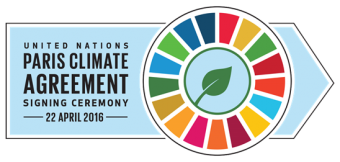 The Paris Climate Change Agreement opens for signature on 22 April 2016 during a high-level ceremony convened by UN Secretary-General Ban Ki-moon in New York, marking an important international push on the way to the agreement’s timely entry into force. Over 130 countries have confirmed to United Nations headquarters that they will attend the signing ceremony, including some 60 world leaders, amongst them President Francois Hollande of France. The event will also be attended by the President of COP21, France’s Segolene Royal, and the Executive Secretary of the UNFCCC, Christiana Figueres.
The Paris Climate Change Agreement opens for signature on 22 April 2016 during a high-level ceremony convened by UN Secretary-General Ban Ki-moon in New York, marking an important international push on the way to the agreement’s timely entry into force. Over 130 countries have confirmed to United Nations headquarters that they will attend the signing ceremony, including some 60 world leaders, amongst them President Francois Hollande of France. The event will also be attended by the President of COP21, France’s Segolene Royal, and the Executive Secretary of the UNFCCC, Christiana Figueres.
All Parties to the UN Framework Convention on Climate Change are invited to sign the agreement, taking note of established international practice that full powers are required to sign. A country’s signature on the agreement initiates the critical domestic process, on which depends its final entry into force. This process takes many separate forms and can be rapid or lengthier, depending on each country’s domestic practices. The outcome may be countries’ instruments of ratification, acceptance, approval or accession. Following each national completion of this process, instruments are submitted to the Depositary under the UN Secretary-General in New York.
It is only once such an instrument is deposited that a country can be said to have ratified the Paris Agreement. The Paris Agreement will enter into force on the 30th day after the date on which at least 55 Parties to the Convention accounting in total for at least an estimated 55 % of total global greenhouse gas emissions have deposited their instruments of ratification, acceptance, approval or accession with the Depositary. An information note on the entry into force of the Paris Agreement is available here: http://unfccc.int/files/paris_agreement/application/pdf/entry_into_force_of_pa.pdf


